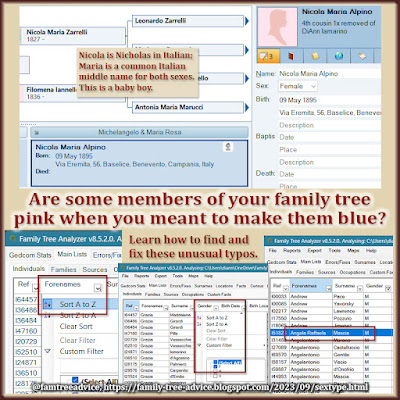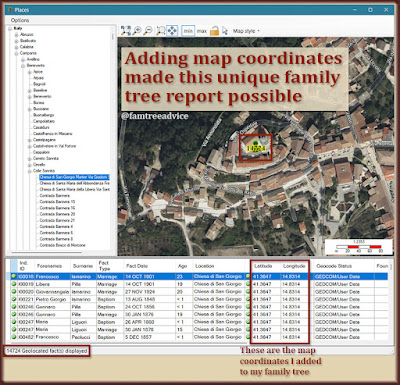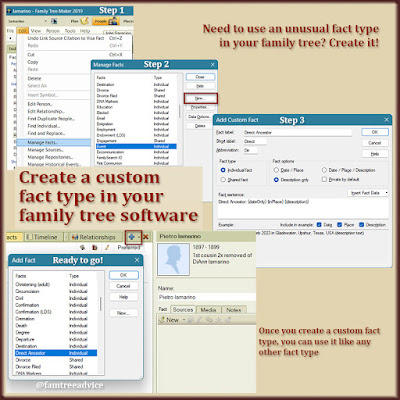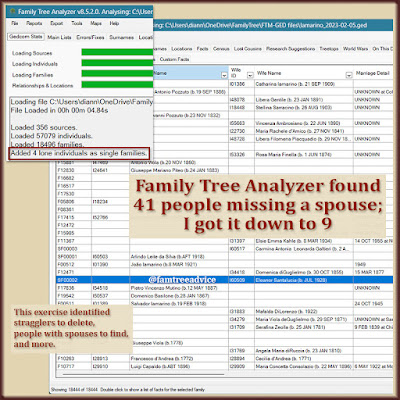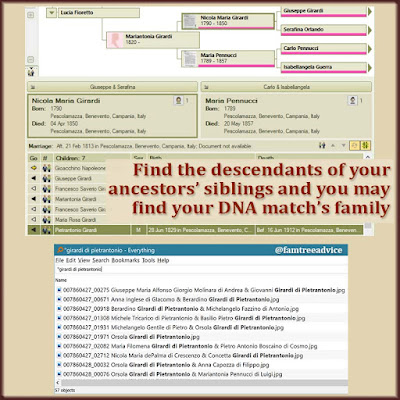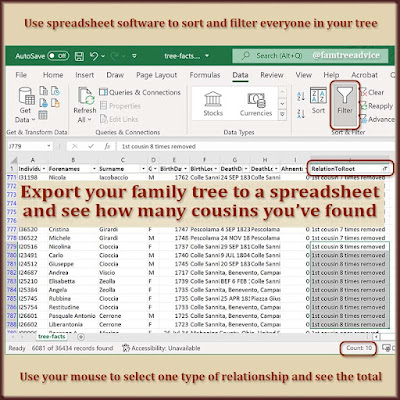My extended family tree of more than 80,000 people keeps on helping my very distant cousins. They get so many hints from my tree that many feel compelled to write to me. Helping them discover their roots is my goal.
But my project to connect all the families from my towns makes me skip most source citations. I know, "Shame, shame!" That's why I spent this past week adding tons of missing source citations. If you find your ancestor in my family tree, I want you to find the links to their vital records, too.
A well-sourced family tree shows the world that you've done your homework. Your tree is valid and worth exploration.
 |
| Without source citations, why should anyone believe your family tree? Follow the genealogy rules and show your work. |
Getting a Handle on Missing Source Citations
After writing "5 Ways to Find Loose Ends in Your Family Tree," I worked my way through people with a missing birth date. I found many of their vital records on the Italian Antenati website. For the sake of speed, instead of a source citation, I added a note to each person that looked like this:
His birth record: https://antenati.cultura.gov.it/ark:/12657/an_ua971481/03dOqgV
It's easy to find those notes when I open my family tree's latest GEDCOM file in a text editor. I search for "His birth record:" and follow the link. Then I create the source citation. This example becomes:
From the Benevento State Archives, 1824 nati, Pago Veiano, document 70, image 43 of 51 at https://antenati.cultura.gov.it/ark:/12657/an_ua971481/03dOqgV; https://iiif-antenati.san.beniculturali.it/iiif/2/03dOqgV/full/full/0/default.jpg
If you're curious, the first link goes to the document in the book of birth records. The second link goes to a high-resolution copy of the vital record. It's perfect for downloading.
If this were your ancestor and you found him in my tree, you'd be able to follow the link and see his birth record. That's the real value I want to provide for anyone with a connection to my family tree. I still have hundreds more of these notes to cite. Then I'll run an Undocumented Fact report in Family Tree Maker and start whittling away.
If your family tree software doesn't have an undocumented facts report, use Family Tree Analyzer:
- Export a GEDCOM file from your family tree and open it with Family Tree Analyzer.
- Go to the Main Lists tab and scroll all the way to the right.
- Find the Num Sources column, click the down arrow by the column title, and choose Sort A to Z.
All the zeroes will be at the top of the list, showing you all the people with no source citations.
I don't know about you, but I never include a source citation for someone's sex. It seems ridiculous to say, "Yeah, the census says Maria was a girl, so that's my source." I just don't think it's necessary or of value. So my undocumented facts report is going to include the sex of all 80,491 people. I have to skip all those entries.
Last Saturday, from about 10 a.m. to 3:30 p.m., all I did was create source citations for those "His birth record:" notes. I completed only 86 of them, so the remaining 447 or more of these notes will take many days to finish. (There are also lots of Her birth record, His and Her death record, and Their marriage record notes.)
Then I'm left with the thousands of people whose vital records are sitting on my computer. I put off their source citations because my priority was getting families into my tree. I knew I could go back and create the citations whenever I wanted. And now I want to.
If you have an overwhelming family tree task like this to do, start close to home. Begin with your closest relatives and fan out. (See "Overwhelming Clean-up Task? Start With Direct Ancestors."). If you use Family Tree Analyzer for this task, sort the list by Source Num and Relation to Root. First you must view the Main Lists tab and choose Export (from the menu at the top of the screen) > Individuals to Excel. Then you can use your spreadsheet software to sort by both Sources and Relation to Root.
Doing that, I see that I have more than 100 direct ancestors who have no source citations. (I'm horrified!) That's where I'll start.
Your Task Won't Be as Huge as Mine
Do you have 80,000 people in your family tree? Did you postpone adding sources in favor of expanding your tree as quickly as possible? If not, then you shouldn't have thousands of missing citations.
I have enough Italian vital records available to add one or two hundred people a day to my family tree for a long time. But for now, I'm putting those additions on the back burner. I want anyone who finds my family tree online to see that I have the documents to back up my facts.
An unsourced family tree lacks credibility. With all the work you've done, do you want your tree to look unreliable?
If you're proud of the family tree you've built, show it! Retrace your steps to find the documents you used to add someone to your tree. Then add each document's source citation to prove you're a thoughtful, careful genealogist. (See "6 Easy Steps to Valuable Source Citations" for help with this task.)
Need help creating your source citations? Don't stress out about it.
- Develop strong habits for creating source citations as you go: "Step-by-Step Source Citations for Your Family Tree"
- Decide which types of sources make your family tree more reliable: "Choosing and Using the Most Reliable Sources"
- Follow a pattern when building your citations: "Add Consistency to Your Source Citations"
Take these steps and show the world that there's solid research behind your family tree.

